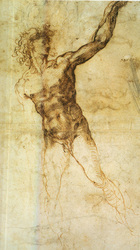Michelangelo
Youth Beckoning c 1503-1504, black and brown ink, 37.5 x 23 cm
Michelangelo drawings are directly linked to his sculptural understanding of form. His understanding of the three dimensional shape of the body informs each mark.
This drawing develops in stages that are linked to senses of touching ,handling and shaping volumes.His drawn mark is an extension , or variation of a shaping hand ( with, say , clay as a medium) or a cutting and shaping chisel on marble.
Michelangelo was quite secretive about his methods and destroyed most of his drawings. I think he may have synthesised a lot of sources to create his figures . He could have combined sections from observation of the living figure, small models , classical sculpture and volumes created from memory to create his monumental figures. Indeed many of the figure poses for the Sistine Chapel are impossible for a living model to imitate as they combine differing viewpoints.
Contours are followed in the legs. Lines indicate the edges of forms ( knee, edge of tibia). The focus on the chest and abdomen is an extension of the contour marks in to a more carefully modelled surface. Some fairly straight parallel hatching creates the ‘down planes ‘ of the breast ( pectoral muscle) rib cage and stomach and the side of the rectus abdominus muscle.
What begins as a modelled form with a broad sense of volume and contour becomes , as it develops, a carved form. Marks in the drawing seem to be used in ways that are close to chiselling. It is as if a visualised volume is carved back in to to render the form more clearly.
The head is a simplified, classical form . It is almost stuck on the the torso as an afterthought.
Michelangelo drawings seem to assemblages . Classical references, observed forms and remembered forms combine. It may be that the torso was drawn from a small model ( similar to the surviving but fragmented Greek and Roman sculpture that were being discovered in Italy) that he made himself. The head seems more of a schematic approach to form created from knowledge of classical sculpture.
Youth Beckoning c 1503-1504, black and brown ink, 37.5 x 23 cm
Michelangelo drawings are directly linked to his sculptural understanding of form. His understanding of the three dimensional shape of the body informs each mark.
This drawing develops in stages that are linked to senses of touching ,handling and shaping volumes.His drawn mark is an extension , or variation of a shaping hand ( with, say , clay as a medium) or a cutting and shaping chisel on marble.
Michelangelo was quite secretive about his methods and destroyed most of his drawings. I think he may have synthesised a lot of sources to create his figures . He could have combined sections from observation of the living figure, small models , classical sculpture and volumes created from memory to create his monumental figures. Indeed many of the figure poses for the Sistine Chapel are impossible for a living model to imitate as they combine differing viewpoints.
Contours are followed in the legs. Lines indicate the edges of forms ( knee, edge of tibia). The focus on the chest and abdomen is an extension of the contour marks in to a more carefully modelled surface. Some fairly straight parallel hatching creates the ‘down planes ‘ of the breast ( pectoral muscle) rib cage and stomach and the side of the rectus abdominus muscle.
What begins as a modelled form with a broad sense of volume and contour becomes , as it develops, a carved form. Marks in the drawing seem to be used in ways that are close to chiselling. It is as if a visualised volume is carved back in to to render the form more clearly.
The head is a simplified, classical form . It is almost stuck on the the torso as an afterthought.
Michelangelo drawings seem to assemblages . Classical references, observed forms and remembered forms combine. It may be that the torso was drawn from a small model ( similar to the surviving but fragmented Greek and Roman sculpture that were being discovered in Italy) that he made himself. The head seems more of a schematic approach to form created from knowledge of classical sculpture.
